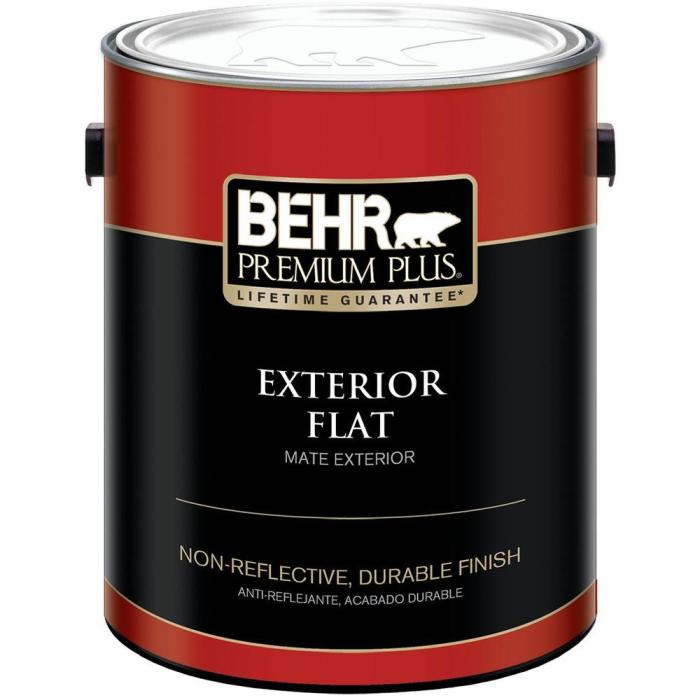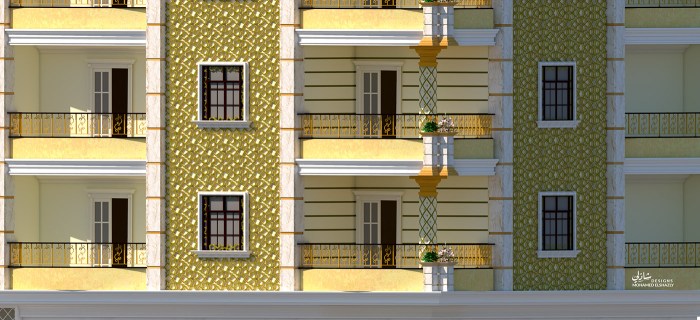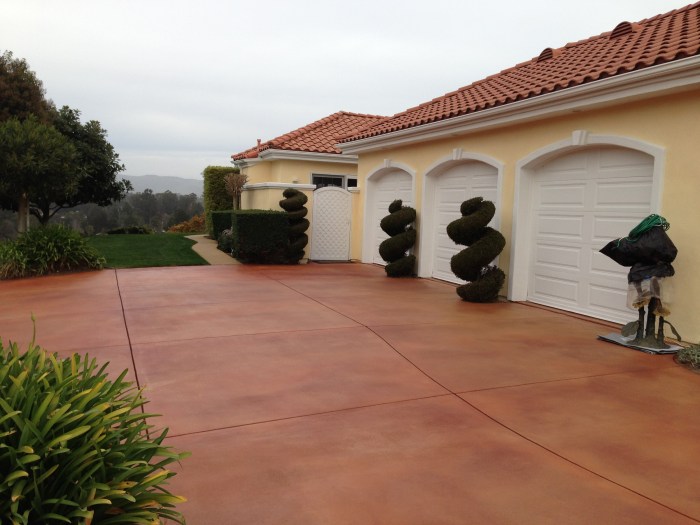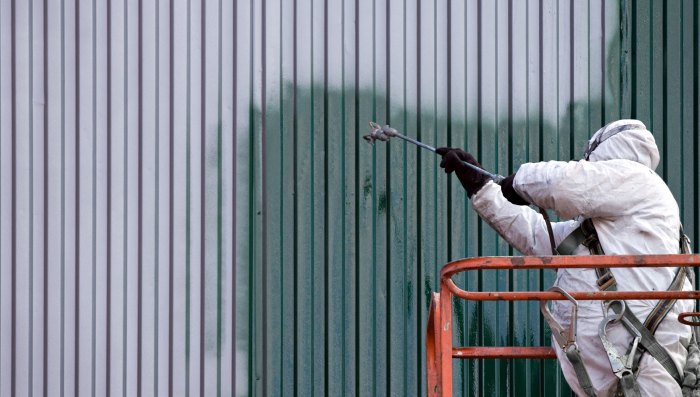Exterior Painting Maintenance A Comprehensive Guide
Exterior painting maintenance is crucial for maintaining your home’s curb appeal and longevity. This guide provides a step-by-step approach to preparing surfaces, selecting the right materials, and maintaining your painted exterior for years to come. Proper preparation, paint selection, and ongoing maintenance are key to achieving a stunning and enduring finish.
From cleaning and prepping the surface to choosing the perfect paint type and finish, this guide covers every essential aspect of exterior painting maintenance. We’ll delve into the specifics of various paint types, their suitability for different climates, and how to address common maintenance issues effectively.
Exterior Painting Preparation: Exterior Painting Maintenance
Proper exterior painting preparation is crucial for a long-lasting and aesthetically pleasing finish. A well-prepared surface ensures that the paint adheres effectively, reducing the risk of peeling, bubbling, or premature deterioration. This involves meticulous cleaning and treatment of the existing surface, removing any loose or damaged material, and creating a smooth, stable foundation for the new paint.
Surface Cleaning
Thorough cleaning of the exterior surface is the initial step in preparation. This involves removing loose debris, dirt, mildew, and other contaminants that can hinder paint adhesion. Pressure washing is an effective method for removing dirt and grime. For tougher stains or mildew, a specialized cleaning solution might be required. Always test any cleaning solution on a small, inconspicuous area first to ensure it doesn’t damage the surface. After cleaning, allow the surface to dry completely before proceeding with further preparation.
Old Paint Removal
Removing old paint is a critical aspect of surface preparation. The chosen method depends on the type of paint, the surface material, and the extent of damage.
- Scraping: This method is suitable for removing loose or flaking paint. A variety of scrapers, from hand-held tools to power scrapers, can be employed. This method is generally effective for soft, deteriorated paint, but can be laborious and may damage the underlying surface if not done carefully. For instance, removing old, peeling paint from a wooden deck often requires careful scraping to avoid damaging the wood’s integrity.
- Sanding: Sanding is a gentler method than scraping, suitable for removing paint that is not excessively loose or damaged. Different grit sandpaper can be used to achieve varying levels of smoothness. Sanding is typically employed when a more uniform surface is required, like before painting metal siding or trim. However, it can be time-consuming for large surfaces.
- Chemical Strippers: Chemical strippers are powerful agents that dissolve old paint. These products can be effective for large areas, but they require careful handling due to their potentially hazardous nature. Always follow the manufacturer’s instructions meticulously, ensuring proper ventilation and personal protective equipment (PPE) usage. Chemical strippers are often preferred for large projects or for surfaces where scraping or sanding is impractical, such as removing thick layers of paint from brick or concrete.
Importance of Surface Preparation
Adequate surface preparation is paramount for a successful paint job. A properly prepared surface allows the new paint to adhere firmly, preventing issues like peeling or blistering. A smooth, clean surface ensures even coverage and a more attractive finish. This translates into a longer lifespan for the paint job, reducing the need for costly repairs and maintenance in the future. For example, a house with consistently well-maintained exterior paint will have lower maintenance costs over its lifetime compared to one with poorly prepared surfaces.
Surface Preparation Techniques Comparison
| Technique | Cost | Time | Effectiveness |
|---|---|---|---|
| Scraping | Generally Low | Variable (depends on the area) | Good for loose paint, but may damage the surface |
| Sanding | Moderate | High (for large areas) | Creates a smooth surface, good for most surfaces |
| Chemical Strippers | Variable (depends on product) | Variable (depends on area and product) | Effective for removing thick layers, but hazardous |
Surface preparation is the foundation of a long-lasting paint job.
Choosing the Right Paint and Materials
Selecting the appropriate paint and materials is crucial for a successful exterior painting project. The right choices will not only enhance the aesthetic appeal but also ensure the longevity and durability of the paint job. Consider factors like the type of house siding, the local climate, and the desired finish when making your selections.
Exterior paints come in various types, each with its own set of advantages and disadvantages. Understanding these differences allows homeowners to make informed decisions based on their specific needs and environmental conditions. Careful consideration of these factors is vital for a lasting and aesthetically pleasing result.
Exterior Paint Types, Exterior painting maintenance
Different exterior paint types offer varying levels of protection and performance. Understanding their properties helps in choosing the best option for your specific needs.
- Acrylic paints are a popular choice for their durability, flexibility, and resistance to weathering. They are relatively easy to apply and offer a wide range of colors and finishes. They typically require less maintenance and are cost-effective.
- Oil-based paints, while durable and long-lasting, require longer drying times and can have a stronger odor during application. They are often more resistant to harsh weather conditions, but their VOC (volatile organic compound) content can be a concern in certain regions.
- Elastomeric paints are known for their ability to stretch and contract with the movement of the substrate. This makes them ideal for areas prone to cracking or for houses with older or damaged siding. They often offer enhanced waterproofing capabilities.
- Alkyd paints, a hybrid between oil-based and acrylic paints, are a versatile option. They offer a balance of durability and drying time, typically providing a good middle ground between oil-based and acrylic paints. Their durability and resistance to fading are key features.
Paint Type Comparisons
The suitability of each paint type varies depending on the climate and conditions.
- Acrylic paints are generally suitable for most climates and provide excellent protection against moisture and UV damage. They are a reliable choice for moderate weather conditions.
- Oil-based paints are a good option for extremely harsh environments with high moisture or temperature fluctuations, where they can provide a higher level of protection. However, the environmental impact and application considerations must be factored in.
- Elastomeric paints are ideal for areas with significant temperature variations or where moisture is a concern, as they help prevent cracking and peeling. They are often preferred in coastal regions or areas with high humidity.
Paint Finishes
Different finishes offer varying levels of sheen and visual appeal. A well-chosen finish complements the architectural style of the home.
| Finish | Features | Benefits |
|---|---|---|
| Matte | Low sheen, flat appearance | Hides imperfections, creates a subtle look |
| Satin | Moderate sheen, soft to the touch | Easy to clean, hides minor imperfections effectively |
| Semi-gloss | Medium sheen, more reflective | Excellent light reflection, easy to clean |
| Gloss | High sheen, very reflective | Excellent durability, easy cleaning, suitable for high-traffic areas |
Primer Selection
Primer is a crucial step in exterior painting, significantly impacting paint adhesion and longevity. It creates a strong base for the topcoat, ensuring better paint coverage and preventing future issues.
A properly applied primer helps prevent moisture penetration, which is a key factor in the long-term performance of exterior paint.
Proper selection of primer is essential for optimal results. Using a primer designed for exterior use and compatible with the chosen paint type ensures the best performance. Matching the primer to the substrate is also important to avoid adhesion problems.
Choosing the Right Paint and Materials for a Project
Several factors determine the best paint and materials for a specific project. Consider these factors carefully to ensure the paint job’s durability and aesthetic appeal.
- Substrate Type: The type of siding (e.g., wood, vinyl, metal) significantly influences paint choice. Matching the paint to the substrate is crucial for optimal adhesion and longevity.
- Climate Conditions: High humidity, extreme temperatures, and high winds can affect paint performance. Selecting paint designed for the local climate is essential.
- Budget: Different paint types and materials have varying costs. A realistic budget helps narrow down the options.
- Desired Appearance: Consider the desired finish and color when making selections.
Maintaining Exterior Painted Surfaces
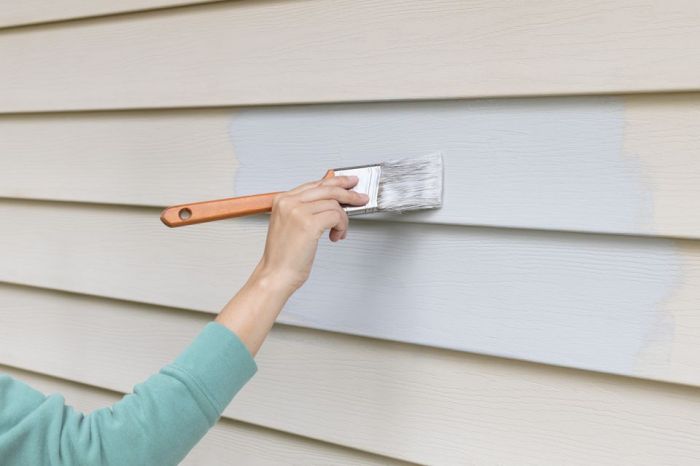
Source: thespruce.com
Proper exterior paint maintenance is crucial for preserving the aesthetic appeal and structural integrity of a building. Regular upkeep can significantly extend the life of the paint job, preventing costly and time-consuming repainting projects. Addressing minor issues promptly prevents them from escalating into major problems.
Exterior paint, like any other material, is susceptible to wear and tear from environmental factors such as sun exposure, rain, temperature fluctuations, and the accumulation of debris. A proactive approach to maintenance is vital in mitigating these issues and ensuring the longevity of the paint.
Common Maintenance Issues and Causes
Regular inspections can reveal potential problems early on. Common issues include chipped, cracked, or peeling paint, discoloration, and the build-up of dirt and grime. These issues are often caused by improper preparation before painting, inadequate surface cleaning, poor-quality paint, or exposure to harsh weather conditions. The severity of the damage often depends on the duration of the exposure and the intensity of the elements. For example, prolonged exposure to intense sunlight can cause paint to fade and crack.
Addressing Minor Damage and Deterioration
Addressing minor damage proactively is essential to prevent larger problems. Prompt action can save time and money, as well as prevent aesthetic issues. These methods include cleaning the affected area, patching small chips or cracks, and repainting sections of the surface. The extent of the repair will depend on the size and severity of the damage.
- Cleaning Painted Surfaces: Regular cleaning removes dirt, grime, and other contaminants that can accelerate deterioration. Use mild detergents and soft-bristled brushes or a pressure washer (carefully). Avoid harsh chemicals that could damage the paint. Proper cleaning is the foundation for effective maintenance, as it removes the initial source of damage.
- Patching Small Damage: For small chips or cracks, use a suitable patching compound, ensuring a good bond with the surrounding paint. Sand and prime the patched area before repainting. Apply the new paint in thin, even coats for optimal results. This is an important step to prevent further damage and maintain a uniform finish.
- Repairing Peeling Paint: Remove all loose, peeling paint using a scraper or putty knife. Clean the area thoroughly. Apply a suitable primer to the bare surface, followed by a new coat of paint. This will prevent further peeling and ensure a consistent finish.
Cleaning Painted Surfaces Effectively
Effective cleaning is crucial for preventing the accumulation of dirt and grime. The build-up of debris can trap moisture, leading to premature paint deterioration. Using appropriate cleaning methods prevents the buildup of dirt and grime, which can lead to paint deterioration.
- Preparation: Assess the extent of the dirt accumulation and the type of paint used. This will dictate the cleaning method. Different paints require different cleaning agents and techniques.
- Cleaning Solution: Use a mild detergent or a specialized exterior paint cleaner. Mix the solution according to the manufacturer’s instructions. Avoid using harsh chemicals, as they can damage the paint.
- Application: Apply the cleaning solution to the surface using a soft-bristled brush or a sponge. Avoid scrubbing too vigorously. Rinse the surface thoroughly with clean water to remove all traces of the cleaning solution. Rinse thoroughly to avoid leaving residue that can harm the paint.
Preventive Maintenance Measures
Implementing preventive measures can significantly extend the life of exterior paint. Regular inspections and prompt maintenance reduce the likelihood of major repairs. This approach to maintenance is essential for longevity and prevents expensive and time-consuming repairs.
| Preventive Measure | Description |
|---|---|
| Regular Inspections | Inspect the painted surface for any signs of damage, such as chips, cracks, or peeling. |
| Cleaning | Regular cleaning removes dirt and grime, preventing moisture buildup and premature paint deterioration. |
| Addressing Minor Issues | Repairing chips, cracks, and peeling paint promptly prevents the issues from worsening. |
| Protective Coatings | Applying a protective coating, such as a sealant, can help shield the paint from harsh weather conditions. |
| Exterior Maintenance Schedule | Establish a schedule for inspecting and maintaining the exterior paint to ensure proactive care. |
Outcome Summary
In conclusion, proper exterior painting maintenance is a multifaceted process that demands attention to detail. By following the Artikeld steps for preparation, material selection, and ongoing upkeep, you can significantly extend the life of your exterior paint job and maintain a beautiful, well-preserved home. The key takeaways include careful surface preparation, choosing appropriate paints for your environment, and regular maintenance to address potential issues proactively. By addressing these critical areas, you are investing in the long-term aesthetic and structural integrity of your home.
